Jan 29, 2013 | Book Reviews
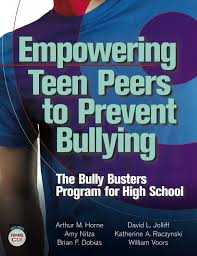 In this manual, the authors provide a research-based model for developing safer and more inviting schools. This well-written manual is logically ordered and based on expertise and experiential success. Teens teaching one another is the cornerstone of this empowerment program. Upperclassmen intensively train to become peer leaders for freshmen, conducting small group sessions during school hours. As the group matures, the leaders focus on building interpersonal and community connections. Teens begin talking about, and honestly listening to individual experiences with bullying, teasing and harassment at school. Trust building becomes the foundation for acceptance and personal growth. Through empathic understanding, students gain courage to confront bullying and avoid passive acceptance. The productive communication training material stresses that “talking at or about” is not communication, whereas listening is the key. Choice-making practice leads students to “stop, think and decide” before acting. Learning about locus of control aids the understanding of how “out there” influences “inside” in decision-making. Practice in conflict resolution helps students center on the STOPP model. Learning about healthy relationships ensures didactic understanding and steers behavioral change.
In this manual, the authors provide a research-based model for developing safer and more inviting schools. This well-written manual is logically ordered and based on expertise and experiential success. Teens teaching one another is the cornerstone of this empowerment program. Upperclassmen intensively train to become peer leaders for freshmen, conducting small group sessions during school hours. As the group matures, the leaders focus on building interpersonal and community connections. Teens begin talking about, and honestly listening to individual experiences with bullying, teasing and harassment at school. Trust building becomes the foundation for acceptance and personal growth. Through empathic understanding, students gain courage to confront bullying and avoid passive acceptance. The productive communication training material stresses that “talking at or about” is not communication, whereas listening is the key. Choice-making practice leads students to “stop, think and decide” before acting. Learning about locus of control aids the understanding of how “out there” influences “inside” in decision-making. Practice in conflict resolution helps students center on the STOPP model. Learning about healthy relationships ensures didactic understanding and steers behavioral change.
Developmentally, the last half of the manual infuses power into the groups’ experiential process. The last two chapters lead students into actualization of their new skills through closure and implementation. This text and its accompanying peer leader guide offer schools a potent and effective way to reduce the venomous, terrifying effects of bullying. Whereas bullying is sometimes written off as “kids being kids,” or “a rite of passage,” adults must accept that bullying is a pernicious malevolence that destroys. With archetypal teen sturm and drang and a brain that can no longer think like a child’s and is incapable yet of full rational adult cognition, even a typical “good” adolescent can fall into the trap of bullying. Bullying may be due to peer pressure, an instinct for social survival, a passive “don’t see–don’t tell” approach, or a combination of all three.
Although this model and the authors’ presentation are sound and strong, one must consider that manuals may not generate results. Effective use of this material requires commitment from dedicated school boards, administrators, teachers and parents. Before starting this program, adult leaders must understand it, have full administrative backing, a strong foundation of parent support, and the kind of group leadership skills and experience that foster solid success. Having worked with teens and schools for several decades, I instantly recognize both the value of this program and the accompanying problems that face even the most dedicated adult leader. Through the program manual, the peer leader guide, and an accompanying CD of forms and handouts, all the necessary tools for success are carefully packaged. To truly succeed, however, the adults implementing this program have to be fully dedicated to total S.U.C.C.E.S.S – Sensitivity, Understanding, Caring, Creativity, Energy, Sincerity, and Support.
Horne, A. M., Nitza, A., Dobias, B. F., Jolliff, D. L., Raczynski, K. A., & Voors, W. (2012). Empowering teen peers to prevent bullying: The bully busters program for high school. Champaign, Illinois: Research Press.
Reviewed by: J. Dwaine Phifer, NCC, DonLin Counseling Services, Statesville, North Carolina.
Jan 29, 2013 | Book Reviews
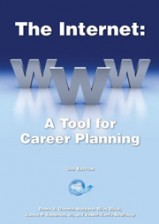 Trying to tame the rapidly changing information on the World Wide Web is daunting, but the additional variable of sorting through reliable and professional sources can seem insurmountable. The Internet: A Tool for Career Planning (3rd ed.) not only helps the reader sort through resources for professionally reviewed online career guidance, but also provides a broad, yet specific approach to using the Internet in multiple forms of career guidance and planning. Essentially, every aspect of the career planning field has been touched by technology, namely the Internet. The Internet: A Tool for Career Planning removes the uncertainty of how to utilize technology when delivering the best career services to a variety of clients.
Trying to tame the rapidly changing information on the World Wide Web is daunting, but the additional variable of sorting through reliable and professional sources can seem insurmountable. The Internet: A Tool for Career Planning (3rd ed.) not only helps the reader sort through resources for professionally reviewed online career guidance, but also provides a broad, yet specific approach to using the Internet in multiple forms of career guidance and planning. Essentially, every aspect of the career planning field has been touched by technology, namely the Internet. The Internet: A Tool for Career Planning removes the uncertainty of how to utilize technology when delivering the best career services to a variety of clients.
The breath of this book is quite impressive. For those who are “Internet challenged,” this text provides a great foundation to gather a baseline of information. Additionally, for those more comfortable with the online environment, this book provides structure for reflective questioning and planning on how to use the Internet in the best way possible for a variety of clients. This book is valuable for traditional colleges and universities wanting to “keep up with the times” by using virtual career centers, and also for private practitioners wanting to provide a variety of easily accessible resources for their clientele. The 100% online education community where I work can benefit from this book as well, when trying to navigate how to complete career counseling via distance modalities.
But what about updating the hundreds of links to career resources and materials included in this book? Happily, the shelf life of this book in this era of the rapid change and flow of information will not become stale because the lists of resources will be updated bi-annually at http://associationdatabase.com/aws/NCDA/pt/sp/resources.
We need to reach students where they are, and these days they are spending a lot of time on their phones and computers with friends and associates. This text provides a guide on how to use social networking, an unfolding service format, to deliver career services.
Perhaps the most useful part of this text for me was the chapter on potential problems and ethical concerns. The authors have taken their expertise and years of experience and shortened the learning curve for their readers. By presenting the potential pitfalls of using the Internet in career planning, they zero in on areas for caution while also providing strategies for avoiding would-be problems. This last chapter certainly made me pause and reflect on specific situations that may arise with my clientele and how I might implement the authors’ strategies for success.
Overall, The Internet: A Tool for Career Planning (3rd ed.) has provided the career planning profession with a go-to guide on how to best utilize the Internet in a wide range of career services with an equally wide range of strategies. This book has a permanent place on my bookshelf and on my Kindle.
Osborn, D. S., Dikel, M. R., & Sampson, J. P. (2011). The Internet: A Tool for Career Planning (3rd ed.). Broken Arrow, OK:National Career Development Association.
Reviewed by: Meagan M. Thrift, Director of Student Services, Centura College, Virginia Beach, Virginia.
The Professional Counselor Journal
HOME PAGE
Jan 9, 2013 | Book Reviews
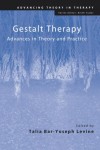 As a graduate student with a basic understanding of Gestalt theory, I found Gestalt Therapy: Advances in Theory and Practice a very thought-provoking read that further explored key concepts and introduced me to contemporary thought on Gestalt theory and practice. The book is a collection of works written by experts in the field and edited by Talia Bar-Yoseph Levine. Bar-Yoseph Levine writes that her intent is to “take Gestalt theoretical view…from ‘now’ into ‘next’” (p. xviii) by inviting Gestalt practitioners and thinkers from diverse backgrounds and languages to “write about that which is closest to his/her heart and that interests them the most” (xix). The result is a bold and varied collection of topics which include Gestalt theory and neuroscience, spirituality, ethics, politics and personality. The book also includes approaches to Gestalt practice and case studies in individual, family, couple and group therapy.
As a graduate student with a basic understanding of Gestalt theory, I found Gestalt Therapy: Advances in Theory and Practice a very thought-provoking read that further explored key concepts and introduced me to contemporary thought on Gestalt theory and practice. The book is a collection of works written by experts in the field and edited by Talia Bar-Yoseph Levine. Bar-Yoseph Levine writes that her intent is to “take Gestalt theoretical view…from ‘now’ into ‘next’” (p. xviii) by inviting Gestalt practitioners and thinkers from diverse backgrounds and languages to “write about that which is closest to his/her heart and that interests them the most” (xix). The result is a bold and varied collection of topics which include Gestalt theory and neuroscience, spirituality, ethics, politics and personality. The book also includes approaches to Gestalt practice and case studies in individual, family, couple and group therapy.
Gestalt Therapy is divided into two parts. Part I includes eight chapters that examine Gestalt therapy and theory from contemporary perspectives. Bar-Yoseph Levine introduces a “gestalt philosophy of being” which expands the principles of Gestalt therapy to just about any human interaction. In another chapter, Erving Polster explores morality and writes about Life Focus Communities. Attending to the embodied relational field, personality as a function of self in society and spirituality in gestalt therapy are examined in subsequent chapters.
Many of the authors in this book challenge conventionally held Gestalt concepts such as holism, awareness, field, projection and the paradoxical theory of change. In some cases, the authors suggest a modification or eradication of the term itself as was the case in Chapter 3, where Charles Bowman suggests that the term “holism” may no longer prove useful in Gestalt therapy because of its numerous implications today. Other chapters offer a challenge to particular Gestalt concepts as is the case in Chapter 6, where Lynne Jacobs questions whether the concept of projection even has value for therapists in a post-Cartesian world.
Part II takes the reader from a discussion of theory into clinical applications for Gestalt therapists including specific examples and case studies. Lolita Sapriel explores the integration of mindfulness practices with traumatized clients and Gary Yontef describes the four relationships in which a therapist is simultaneously engaged during couple therapy. Brian O’Neill investigates the use of field perspective in family therapy and Sean Gaffney outlines Gestalt with groups using a contemporary reconsideration of the work of Kurt Lewin.
Bar-Yoseph Levine includes an epilogue which contains two articles. The first concerns ethics and ethical behavior by Ernst Kniff which suggests shifting the focus from rules to awareness. Phillip Lichtenberg describes the cultural aspect of Gestalt theory in our everyday conversations, especially where strong feelings come into play in discourse about politics and religion.
Gestalt Therapy: Advances in Theory and Practice is a comprehensive and thoughtful exploration of Gestalt theory and practice written by a diverse group of contemporary thinkers. This collection is a brave and honest examination of Gestalt therapy which seems to fulfill the editor’s wish to take the “now” into the “next.”
Levine, T. B. (Ed). (2012). Gestalt Therapy: Advances in theory and practice (Ed.). New York, NY: Routledge.
Review by: Teresa Siegle Prevatte, Wake Forest University.
The Professional Counselor Journal
http://tpcjournal.nbcc.org
Jan 9, 2013 | Book Reviews
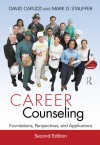 In David Capuzzi and Mark Stauffer’s most recent edition of Career Counseling: Foundations, Perspectives, and Applications, they provide a holistic, comprehensive, insightful, interesting and highly organized (e.g., individual chapter outlines) resource for graduate students and professionals working in the career and mental health counseling fields. Furthermore, the title of this publication accurately describes its purpose, contents and overall themes. For example, the authors provide an extensive historical background on the foundation of career counseling and explain how socio-cultural, economic, and technological changes have influenced current theory and practice. Similarly, the textbook is filled with assessment tools, clinical techniques, case studies, practical examples, and visual guidelines on how to assist special populations (e.g., individuals with disabilities). In addition to the author’s clear writing style, ability to define key terms, and inclusion of helpful sidebars, the text demonstrates the importance of integrating career and mental health concerns.
In David Capuzzi and Mark Stauffer’s most recent edition of Career Counseling: Foundations, Perspectives, and Applications, they provide a holistic, comprehensive, insightful, interesting and highly organized (e.g., individual chapter outlines) resource for graduate students and professionals working in the career and mental health counseling fields. Furthermore, the title of this publication accurately describes its purpose, contents and overall themes. For example, the authors provide an extensive historical background on the foundation of career counseling and explain how socio-cultural, economic, and technological changes have influenced current theory and practice. Similarly, the textbook is filled with assessment tools, clinical techniques, case studies, practical examples, and visual guidelines on how to assist special populations (e.g., individuals with disabilities). In addition to the author’s clear writing style, ability to define key terms, and inclusion of helpful sidebars, the text demonstrates the importance of integrating career and mental health concerns.
The second edition includes eighteen chapters and is organized using the following three sections: (a) foundations for career counseling, (b) skills and techniques, and (c) contextual perspectives on career and lifestyle planning. The initial chapters provide a historical overview, describing theoretical foundations and emphasizing a holistic perspective. One useful chapter discusses the need for multicultural and social justice competence while another chapter reviews ethical, legal and accreditation standards. Topics related to conducting individual and group assessment, utilizing technology in practice, creating career action plans, implementing and designing career programs, and engaging in supervision are addressed over five chapters. Finally, the remaining chapters focus on career and lifestyle planning for specific populations (e.g., middle school students; dual-career families; drug users).
Incorporating contributions from more than thirty-five experts in the counseling, career, school, and social work disciplines, Capuzzi and Stauffer provide comprehensive information that was empirically supported and highly applicable to current trends in the career counseling field (e.g., dual career couples). Furthermore, this text included powerful statistics that concurrently ensured the depth, breadth, and currency of all sources cited. Also, descriptive case studies (e.g., chapter 6), additional website links (e.g., chapter 9), and visual graphs and tables (chapter 15) are used throughout the textbook to enhance clarity and understanding among its audience. Additional strengths are related to the addressing of gaps within the literature describing special populations, such as integrating principles of personal and career counseling with anxiety, and depression that often interfere with making career decisions. Similarly, Capuzzi and Stauffer note how career theories (e.g., Hershenson’s model of work adjustment) can be used for individuals with disabilities who present with poor self-concept. Finally, the authors adequately address the multiple roles of career counselors (e.g., consultants, practitioners, and program managers) and how to use strategic planning when developing career programs.
While Capuzzi and Stauffer’s textbook included numerous strengths, the publication was not without some limitations. One area for improvement is expanding content and information displayed in the sidebar sections. For example, potential answers to questions could be included at the end of each chapter so that the reader can compare responses. While talking about social justice, access and equity, it would be beneficial to discuss cost-effective service delivery models that can be used when working with clients seeking services. Finally, adding examples, role plays or additional information could have strengthened the supervision chapter.
In summary, Career Counseling: Foundations, Perspectives, and Applications (2012) demonstrates how theory can be translated into practice. It represents a comprehensive and valuable resource that significantly contributes to the field of career and mental health counseling. Whether for first-year graduate students or advanced professionals in the field, this text will serve as a useful resource that can be used across a variety of client populations and presenting concerns.
Capuzzi, D. & Stauffer, M. (2012). Career counseling: Foundations, perspectives, and applications (2nd Ed.) New York, NY: Routledge.
Review by: Mary-Catherine McClain, Florida State University Career Center.
The Professional Counselor Journal
HOME PAGE
Jan 9, 2013 | Book Reviews
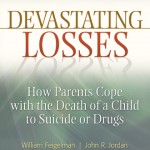 In addition to tugging on my heartstrings, Devastating Losses: How Parents Cope with the Death of a Child to Suicide or Drugs captivated my clinical quest for knowledge. The authors combined personal stories of survivors who lost children to suicide or drug related deaths with a profundity of solid quantitative research and clinical experience. This book begins with the personal journey of two of the authors who experienced the suicide of their own son and explores their devastations, emotional struggles, and the healing processes they encountered. The authors have published multiple research articles in leading journals such as Death Studies, Omega: Journal of Death & Dying, and Illness, Crisis, and Loss. This prior research served as the underpinning to the intensive research that was performed to produce this pinnacle publication.
In addition to tugging on my heartstrings, Devastating Losses: How Parents Cope with the Death of a Child to Suicide or Drugs captivated my clinical quest for knowledge. The authors combined personal stories of survivors who lost children to suicide or drug related deaths with a profundity of solid quantitative research and clinical experience. This book begins with the personal journey of two of the authors who experienced the suicide of their own son and explores their devastations, emotional struggles, and the healing processes they encountered. The authors have published multiple research articles in leading journals such as Death Studies, Omega: Journal of Death & Dying, and Illness, Crisis, and Loss. This prior research served as the underpinning to the intensive research that was performed to produce this pinnacle publication.
The book is organized into three main sections. In section I, the authors explore the specific characteristics of the trauma of losing a child to suicide or drugs. There is difficulty and pain in the death of a child no matter the cause; however death that results from self-infliction generates an entirely unique experience for survivors. Bereaved parents of children who have died as a result of suicide or drugs often encounter stigmatization as opposed to parents who have lost children to purely accidental or natural deaths. The stigma is usually very subtle and is many times conveyed by family members and significant others. This can be very painful for survivors and can complicate the grieving process. By understanding the distinctive experiences of these bereaved parents, clinicians can develop empathy and awareness of the many facets that often complicate the grieving process for survivors.
Section II includes specific resources that will help parents who have experienced a death of a child due to self-inflicted trauma. The usefulness of commonly employed help-seeking activities such as support groups, mental health/bereavement counseling sessions, clergy meetings, and psychic visits is explored in this section. Data from both early and later years after losing a child is included. The studies of long-term resources, which include supportive services after 10 years are not well-researched according to the authors, which lends to another added benefit of the book. This section offers a review of resources based on the voices of the research participants that will help clinicians make well-informed referrals to enhance quality treatment.
In section III, the authors investigate the impact of a child’s traumatic death on married couples. In addition to the exploration of the marital relationship, gender differences in how men and women react to a violent death of a child are studied. When married couples experience the death of a child to suicide or drugs, relational patterns are challenged by the presence of grief and other complicated factors. Many times marriages dissolve when a traumatic loss of a child is encountered and understanding the ways that males and females process grief and experience healing can be very therapeutic for a couple. This section is designed to help men and women develop a cultural understanding of their individual grief patterns and develop cohesion rather than dissonance in a marriage experiencing the death of a child.
This book is written through a personal and professional lens which provides hope to both healing parents and clinicians. For clinicians, school counselors, or mental health professionals, this book provides an option of treatment based on evidenced based research. In addition, service providers can feel confident that they are operating from a research-based and humanistic framework to nurture clients through the trauma of dealing with the devastating loss of a child.
Feigelman, W., Jordan, J.R., McIntosh, J.L., & Feigelman, B. (2012). Devastating losses: How parents cope with the death of a child to suicide or drugs. New York: Springer.
Review by: Jane Hale, Slippery Rock University.
The Professional Counselor Journal
http://tpcjournal.nbcc.org
 In this manual, the authors provide a research-based model for developing safer and more inviting schools. This well-written manual is logically ordered and based on expertise and experiential success. Teens teaching one another is the cornerstone of this empowerment program. Upperclassmen intensively train to become peer leaders for freshmen, conducting small group sessions during school hours. As the group matures, the leaders focus on building interpersonal and community connections. Teens begin talking about, and honestly listening to individual experiences with bullying, teasing and harassment at school. Trust building becomes the foundation for acceptance and personal growth. Through empathic understanding, students gain courage to confront bullying and avoid passive acceptance. The productive communication training material stresses that “talking at or about” is not communication, whereas listening is the key. Choice-making practice leads students to “stop, think and decide” before acting. Learning about locus of control aids the understanding of how “out there” influences “inside” in decision-making. Practice in conflict resolution helps students center on the STOPP model. Learning about healthy relationships ensures didactic understanding and steers behavioral change.
In this manual, the authors provide a research-based model for developing safer and more inviting schools. This well-written manual is logically ordered and based on expertise and experiential success. Teens teaching one another is the cornerstone of this empowerment program. Upperclassmen intensively train to become peer leaders for freshmen, conducting small group sessions during school hours. As the group matures, the leaders focus on building interpersonal and community connections. Teens begin talking about, and honestly listening to individual experiences with bullying, teasing and harassment at school. Trust building becomes the foundation for acceptance and personal growth. Through empathic understanding, students gain courage to confront bullying and avoid passive acceptance. The productive communication training material stresses that “talking at or about” is not communication, whereas listening is the key. Choice-making practice leads students to “stop, think and decide” before acting. Learning about locus of control aids the understanding of how “out there” influences “inside” in decision-making. Practice in conflict resolution helps students center on the STOPP model. Learning about healthy relationships ensures didactic understanding and steers behavioral change.
 As a graduate student with a basic understanding of Gestalt theory, I found Gestalt Therapy: Advances in Theory and Practice a very thought-provoking read that further explored key concepts and introduced me to contemporary thought on Gestalt theory and practice. The book is a collection of works written by experts in the field and edited by Talia Bar-Yoseph Levine. Bar-Yoseph Levine writes that her intent is to “take Gestalt theoretical view…from ‘now’ into ‘next’” (p. xviii) by inviting Gestalt practitioners and thinkers from diverse backgrounds and languages to “write about that which is closest to his/her heart and that interests them the most” (xix). The result is a bold and varied collection of topics which include Gestalt theory and neuroscience, spirituality, ethics, politics and personality. The book also includes approaches to Gestalt practice and case studies in individual, family, couple and group therapy.
As a graduate student with a basic understanding of Gestalt theory, I found Gestalt Therapy: Advances in Theory and Practice a very thought-provoking read that further explored key concepts and introduced me to contemporary thought on Gestalt theory and practice. The book is a collection of works written by experts in the field and edited by Talia Bar-Yoseph Levine. Bar-Yoseph Levine writes that her intent is to “take Gestalt theoretical view…from ‘now’ into ‘next’” (p. xviii) by inviting Gestalt practitioners and thinkers from diverse backgrounds and languages to “write about that which is closest to his/her heart and that interests them the most” (xix). The result is a bold and varied collection of topics which include Gestalt theory and neuroscience, spirituality, ethics, politics and personality. The book also includes approaches to Gestalt practice and case studies in individual, family, couple and group therapy. In David Capuzzi and Mark Stauffer’s most recent edition of Career Counseling: Foundations, Perspectives, and Applications, they provide a holistic, comprehensive, insightful, interesting and highly organized (e.g., individual chapter outlines) resource for graduate students and professionals working in the career and mental health counseling fields. Furthermore, the title of this publication accurately describes its purpose, contents and overall themes. For example, the authors provide an extensive historical background on the foundation of career counseling and explain how socio-cultural, economic, and technological changes have influenced current theory and practice. Similarly, the textbook is filled with assessment tools, clinical techniques, case studies, practical examples, and visual guidelines on how to assist special populations (e.g., individuals with disabilities). In addition to the author’s clear writing style, ability to define key terms, and inclusion of helpful sidebars, the text demonstrates the importance of integrating career and mental health concerns.
In David Capuzzi and Mark Stauffer’s most recent edition of Career Counseling: Foundations, Perspectives, and Applications, they provide a holistic, comprehensive, insightful, interesting and highly organized (e.g., individual chapter outlines) resource for graduate students and professionals working in the career and mental health counseling fields. Furthermore, the title of this publication accurately describes its purpose, contents and overall themes. For example, the authors provide an extensive historical background on the foundation of career counseling and explain how socio-cultural, economic, and technological changes have influenced current theory and practice. Similarly, the textbook is filled with assessment tools, clinical techniques, case studies, practical examples, and visual guidelines on how to assist special populations (e.g., individuals with disabilities). In addition to the author’s clear writing style, ability to define key terms, and inclusion of helpful sidebars, the text demonstrates the importance of integrating career and mental health concerns. In addition to tugging on my heartstrings, Devastating Losses: How Parents Cope with the Death of a Child to Suicide or Drugs captivated my clinical quest for knowledge. The authors combined personal stories of survivors who lost children to suicide or drug related deaths with a profundity of solid quantitative research and clinical experience. This book begins with the personal journey of two of the authors who experienced the suicide of their own son and explores their devastations, emotional struggles, and the healing processes they encountered. The authors have published multiple research articles in leading journals such as Death Studies, Omega: Journal of Death & Dying, and Illness, Crisis, and Loss. This prior research served as the underpinning to the intensive research that was performed to produce this pinnacle publication.
In addition to tugging on my heartstrings, Devastating Losses: How Parents Cope with the Death of a Child to Suicide or Drugs captivated my clinical quest for knowledge. The authors combined personal stories of survivors who lost children to suicide or drug related deaths with a profundity of solid quantitative research and clinical experience. This book begins with the personal journey of two of the authors who experienced the suicide of their own son and explores their devastations, emotional struggles, and the healing processes they encountered. The authors have published multiple research articles in leading journals such as Death Studies, Omega: Journal of Death & Dying, and Illness, Crisis, and Loss. This prior research served as the underpinning to the intensive research that was performed to produce this pinnacle publication.